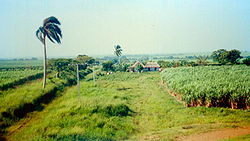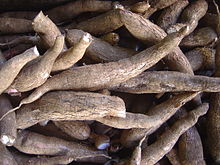- Agriculture in Cuba
-
 Sugarcane plantation in rural Cuba
Sugarcane plantation in rural Cuba
Agriculture in Cuba has played an important part in the economy for several hundred years. Agriculture contributes less than 10 percent to the gross domestic product (GDP), but it employs roughly one fifth of the working population. About 30 percent of the country's land is used for crop cultivation.[1]
The inefficient agricultural industry in Cuba has led to the need to import large amounts of foods.[2] Cuba now imports about 80% of the food it rations to the public.[2] The rationing program accounts for about a third of the food energy the average Cuban consumes.[3]
Contents
History
Cuba's agricultural history can be divided into five periods, reflecting Cuban history in general:
- Precolonial (before 1492)
- Spanish colonial (1492–1902)
- United States Neocolonial (1902–1958)
- Socialist Cuba, pre-Socialist bloc collapse (1959–1989)
- Socialist Cuba, post-Socialist bloc collapse (1989–present)
During each of these periods, agriculture in Cuba has confronted unique obstacles and undergone numerous challenges.
Before the revolution 1959, the agricultural sector in Cuba was largely oriented towards and dominated by the US economy. After the communist government took over, the Soviet Union supported the Cuban agriculture by paying premium prices for Cuba's main agricultural product, sugar, and by delivering fertilizers. Sugar was bought by the Soviets at more than five times the market price. Also 95 percent of its citrus crop was exported to the COMECON. On the other hand, the Soviets provided Cuba with 63 percent of its food imports and 90 percent of its petrol.[4]
After the collapse of the Soviet Union in 1991, the Cuban agricultural sector faced a very difficult period. The agricultural production fell by 54% between 1989 and 1994.[5] The answer of the Cuban government was to strengthen the base of agricultural biodiversity by making a greater range of varieties of seed available to farmers.[6] In the 1990s, the Cuban government prioritized food production and put the focus on small farmers.[4] Already in 1994, the government allowed farmers to sell their surplus production directly to the population. This was the first move to lift the state's monopoly on food distribution.[7] Due to the shortage in artificial fertilizers and pesticides, the Cuban agricultural sector largely turned organic,[8] with the Organopónicos playing a major role in this transition.
Today, there are several different forms of agricultural production, including cooperatives such as UBPCs (Unidad Básica de Producción Cooperativa) and CPAs (Cooperativa de Producción Agropecuaria).
Some of this is described in the documentary The Power of Community: How Cuba Survived Peak Oil.[9]
Urban agriculture
Due to the shortage of fuel and therefore severe deficiencies in the transportation sector a growing percentage of the agricultural production takes place in the so-called urban agriculture. In 2002, 35,000 acres (140 km2) of urban gardens produced 3.4 million metric tons of food. Current estimates are as high as 81,000 acres (330 km2).[10] In Havana, 90% of the city's fresh produce come from local urban farms and gardens. In 2003, more than 200,000 Cubans worked in the expanding urban agriculture sector.[11]
Crops
Sugar
Until the 1960s, the USA received 33% of their sugar imports from Cuba. However, the sugar production in the cane sugar mills has fallen from approximately 8 million metric tons to 3.2 million metric tons in the 1990s.
Today, Cuba has become a net exporter of sugar.
Tobacco
Cuba has the second largest area planted with tobacco of all countries worldwide.[12] Tobacco production in Cuba has remained about the same since the late 1990s. Cigars are a famous Cuban product worldwide and almost the whole production is exported.[13] The center of Cuban tobacco production is the Pinar del Río Province. Tobacco is the third largest source of hard currency for Cuba.[14] The income derived from the cigars is estimated at US$200 million.[15] The two main varieties grown in Cuba are Corojo and Criollo. 85% of the tobacco grown in Cuba is produced by National Association of Small Farmers members.[16]
See also: Cuban cigarsCitrus
Cuba is the world's third largest producer of grapefruit. Sixty percent of the citrus production are oranges, 36% grapefruit.[5] In the citrus production the first foreign investment in Cuba's agricultural sector took place: In 1991, the participation of an enterprise from Israel in the production and processing of citrus is the Jagüey Grande area, approximately 140 km (90 mi) east of Havana, was officially recognized.[17] The products are mainly marketed in Europe under the brand name Cubanita.
Rice
Rice plays a major role in the Cuban diet. Rice in Cuba is mostly grown along the western coast. There are two crops per year. The majority of the rice farms are state-farms or belong to co-operatives.[18] Cuba has been a major importer of rice. Recently, the annual rice imports have approached 500 000 tonnes of milled rice. The production of rice is limited due to the shortage of water and similar to other industries in Cuba the lack of fertilizers and modern agricultural technology. The yield per hectare remains lower than the average of Central American and Caribbean countries.[19]
Potato
The per capita consumption of potatoes in Cuba amounts to 25 kg (55 lb) per year. Potatoes are mainly consumed as French fries. The potato production areas (in total 37,000 acres or 150 square kilometres) are concentrated in the Western part of Cuba. The main variety grown in Cuba is the Désirée.[20] Seed potatoes are partly produced locally. Some 40,000 metric tons of seed potatoes are imported annually from New Brunswick, Canada and the Netherlands.[21]
Cassava
Some 260,000 acres (1,100 km2) are planted with cassava.[22] The cassava originates from the Latin American and Caribbean region[23] and is grown in almost every country of the region. Cuba is the second largest producer of cassava in the Caribbean with a production of 300,000 t (2001).[24] However, the yield per hectare is the lowest of all Caribbean countries. Most of Cuba's production is used directly for fresh consumption.[25] Part of the cassava is processed to sorbitol in a plant near Florida, Central Cuba.[26]
Tropical fruits
Plantains and bananas account for over 70 percent of production with plantain 47% and banana 24% of the local production. Both are only produced for domestic consumption.[27] Other tropical fruits produced in Cuba are mango, papaya, pineapple, avocado, guava, coconut, and anonaceae (sugar apple family).
See also
- Agrarian Reform Laws of Cuba
- Special Period - Change in agriculture
References
- ^ Britannica Online
- ^ a b "Cuban leader looks to boost food production". CNN. April 17, 2008. http://www.cnn.com/2008/WORLD/americas/04/16/cuba.farming/index.html.
- ^ Snow, Anita (2 July 2007). "Living on Cuban Food Ration Isn't Easy". Washington Post. http://www.washingtonpost.com/wp-dyn/content/article/2007/07/02/AR2007070201103.html. Retrieved 2010-04-23.
- ^ a b Cuba's agricultural revolution an example to the world - by Andrew Buncombe
- ^ a b http://www.ers.usda.gov/publications/agoutlook/oct1998/ao255h.pdf
- ^ cuba-agriculture.com - Cuba Agriculture History
- ^ The New York Times, January 10, 1995 - Cuba's Agriculture Shows Improvements
- ^ A Different Kind of Green Revolution in Cuba by Hal Hamilton
- ^ The Power of Community: How Cuba Survived Peak Oil
- ^ Seattle Post-Intelligencer
- ^ Cuban Ministry of Agriculture
- ^ Nation´s encyclopedia
- ^ "MSN encarta". Archived from the original on 2009-10-31. http://www.webcitation.org/5kwDZUejX.
- ^ Cubanet
- ^ CNN: The color and complexity of Cuba’s cigars April 9, 2007
- ^ Sinclair, Minor; Martha Thompson (2007). "Agricultural Crisis and Transformation". A Contemporary Cuba Reader: Reinventing the Revolution. Rowman & Littlefield,. pp. 158. ISBN 0-7425-5507-0.
- ^ http://lanic.utexas.edu/project/asce/pdfs/volume11/rossmayo.pdf
- ^ FAO Corporate Document Repository
- ^ FAO Corporate Document Repository
- ^ World Potato Atlas
- ^ Cuba works toward seed potato deal with North Dakota in: The Bismarck Tribune.com
- ^ Cuba´s Non-Sugar Agriculture
- ^ http://www.ciat.cgiar.org/webciat/asia_cassava/pdf/proceedings_workshop_00/632.pdf
- ^ Foodmarket Exchange
- ^ FAO Corporate Document Repository
- ^ EVD - The Netherlands
- ^ USDA 2004
External links
- Andrew Buncombe The good life in Havana: Cuba's green revolution The Independent 8 August 2006
- [1]
Agriculture in North America Sovereign states - Antigua and Barbuda
- Bahamas
- Barbados
- Belize
- Canada
- Costa Rica
- Cuba
- Dominica
- Dominican Republic
- El Salvador
- Grenada
- Guatemala
- Haiti
- Honduras
- Jamaica
- Mexico
- Nicaragua
- Panama
- Saint Kitts and Nevis
- Saint Lucia
- Saint Vincent and the Grenadines
- Trinidad and Tobago
- United States
Dependencies and
other territories- Anguilla
- Aruba
- Bermuda
- Bonaire
- British Virgin Islands
- Cayman Islands
- Curaçao
- Greenland
- Guadeloupe
- Martinique
- Montserrat
- Puerto Rico
- Saint Barthélemy
- Saint Martin
- Saint Pierre and Miquelon
- Saba
- Sint Eustatius
- Sint Maarten
- Turks and Caicos Islands
- United States Virgin Islands
Categories:
Wikimedia Foundation. 2010.


